In 2025 nuclear energy has returned to the center of global energy policy. After more than a decade of neglect following Fukushima, governments and investors are once again focused on uranium and the companies that produce it. Electricity prices are close to multi-year highs, utilities are securing long-term supply agreements, and capital markets are rewarding firms positioned to meet this renewed demand.
The reasons are clear. Energy security has become a political priority after Europe’s heavy reliance on Russian gas exposed deep vulnerabilities. At the same time, climate commitments are accelerating as nations pursue net-zero targets. In that context, nuclear power is increasingly recognised as the only scalable source of low-carbon baseload electricity that can complement intermittent renewables such as wind and solar.
Meanwhile, geopolitics are reshaping uranium markets. Russia’s dominance in enrichment and fuel-cycle services has pushed the United States, Canada, and Europe to diversify supply chains and strengthen domestic capabilities. This shift is creating new opportunities for uranium miners in politically stable regions, where governments are eager to secure reliable fuel sources for both current and future reactors.
Capital is moving across the nuclear value chain. Governments are extending reactor lifespans, approving new builds, and supporting domestic uranium production. Innovative firms such as Oklo, TerraPower, and X-energy are drawing investment into next-generation reactor technologies. Traditional miners are restarting long-idled projects and fast-tracking new developments in Canada, Australia, Namibia, and Niger.
For investors this is a rare alignment: structural demand growth, geopolitical urgency, and tight supply. Uranium miners sit at the foundation of this story. Without secure uranium supply, neither today’s reactors nor tomorrow’s advanced designs can operate. The recent surge of inflows into uranium-focused ETFs highlights how both institutional and retail investors are positioning for this trend.
This article reviews eleven uranium mining stocks to know in 2025. From global leaders such as Cameco and Kazatomprom to high-growth developers like NexGen Energy and Global Atomic, these companies form the backbone of a sector that is once again central to global energy markets.
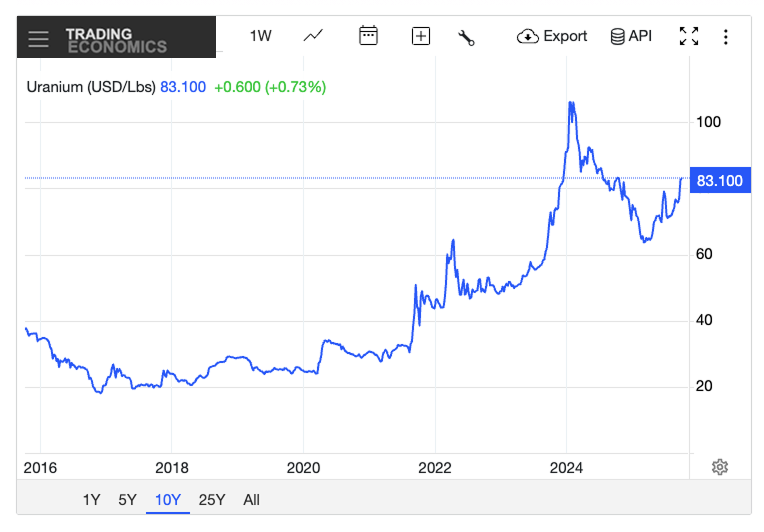
Why Uranium Matters
Energy Security
Nuclear energy offers countries the ability to generate large amounts of electricity without relying on fossil fuel imports. In the wake of the 2022–2023 energy crisis, Europe and Asia are accelerating their pursuit of secure uranium supply chains.
Net-Zero Goals
Decarbonisation is impossible without stable baseload power. Wind and solar are critical, but they are intermittent. Nuclear provides a constant flow of low-carbon electricity, making it the backbone of many national energy strategies.
Geopolitical Reality
Russia controls a large share of the world’s uranium enrichment capacity. This has created urgency in the U.S. and Europe to diversify both mining and enrichment away from Russian influence. Western miners stand to benefit as governments push for strategic independence.
Expanding Demand
According to the World Nuclear Association, uranium demand is projected to grow 28 percent by 2030 and nearly double by 2040 as more reactors come online and existing fleets operate longer.
How Uranium Mining Works
Uranium is not mined in the same way as coal or oil. Because it occurs in specific types of rock and often at low concentrations, it requires specialized methods. The three main approaches are:
- Open-pit mining – This is used when uranium deposits are close to the surface. Large areas of rock are removed to access the ore, similar to how copper is mined.
- Underground mining – When uranium lies deeper underground, miners create tunnels to reach high-grade deposits. This method is common in places like Canada’s Athabasca Basin, where uranium concentrations are some of the richest in the world.
- In-situ recovery (ISR) – Instead of digging, miners pump a solution into underground ore bodies. This dissolves the uranium, which is then pumped back to the surface. ISR is generally lower-cost and less disruptive to the environment. It is the dominant method in Kazakhstan and is also used in parts of the United States.
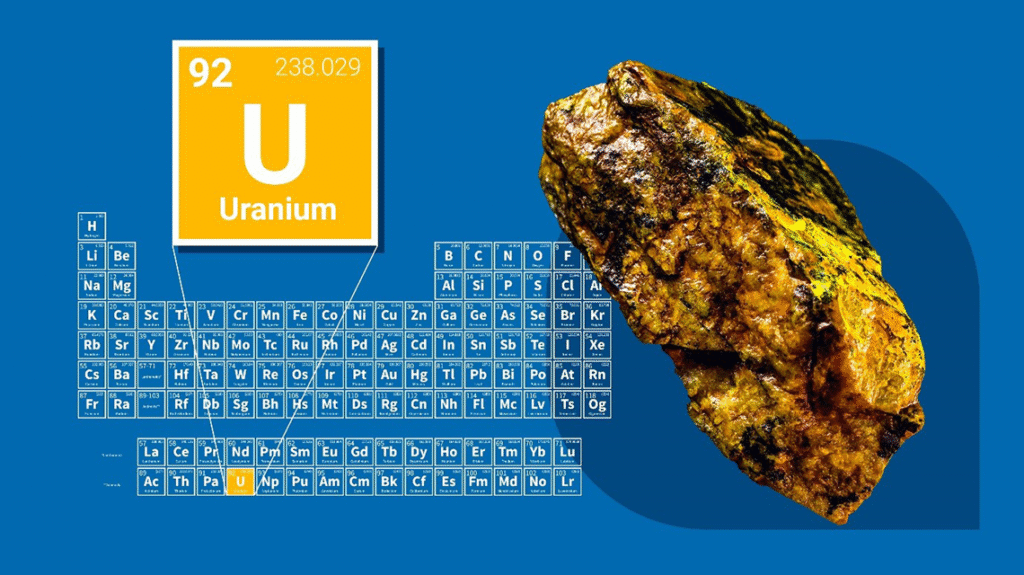
Key Producing Regions
- Kazakhstan – The world’s largest producer, supplying over 40% of global uranium output. Production is dominated by Kazatomprom, which relies heavily on low-cost in-situ recovery (ISR) methods.
- Canada – Home to the Athabasca Basin in Saskatchewan, which hosts some of the highest-grade uranium deposits on Earth. Mines like Cigar Lake and McArthur River (operated by Cameco) produce uranium with concentrations far richer than the global average.
- Australia and Namibia – Both countries rank among the top producers. Australia has the largest known uranium reserves globally, with mines such as Olympic Dam and Ranger. Namibia is a major exporter through operations like Rossing and Husab, which supply utilities around the world.
- United States – Once a leading uranium producer, U.S. output has declined significantly. However, smaller-scale producers are restarting idled mines in Wyoming, Texas, and Utah, encouraged by government policies that support domestic uranium supply and reduce dependence on imports.
Factors Driving Uranium Prices
1. Supply and Demand Imbalance
Years of low prices led to mine closures and under-investment. Demand is now rising, but supply has been slow to respond, creating a tightening market.
2. Long-Term Utility Contracts
Unlike oil or copper, uranium is mostly sold through multi-year contracts between utilities and miners. Prices in these contracts often lag spot market moves, meaning miners can lock in stable cash flows during bull cycles.
3. Government Policy
Policies to extend or build new reactors directly increase uranium demand. Incentives for domestic mining in the U.S. and Europe also support local producers.
4. Geopolitical Tensions
Sanctions on Russia or instability in supplier nations such as Niger can disrupt supply, driving prices higher.
5. Investor Activity
The entry of funds such as the Sprott Physical Uranium Trust (SPUT), which buys and holds physical uranium, has tightened spot markets and added new financial demand.
Top Uranium Mining Stocks (A to U)
Cameco (CCJ, CCO.TO) – Canada
- What It Does: One of the world’s largest uranium producers (delivers 17% of annual global supply), operating the high-grade McArthur River and Cigar Lake mines in Canada’s Athabasca Basin.
- Catalysts: Restart of McArthur River; long-term utility contracts; diversification into nuclear services via joint ownership of Westinghouse (with Brookfield).
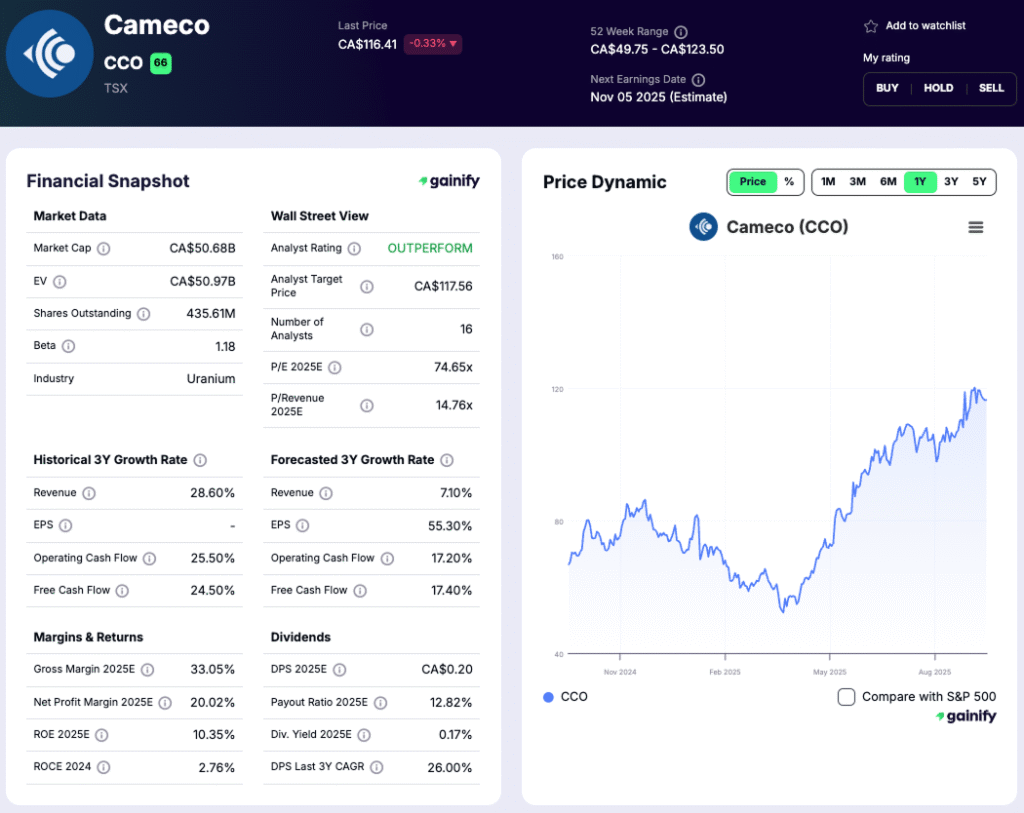
Kazatomprom (KAP.L, KZAP.KZ) – Kazakhstan
- What It Does: The largest uranium producer globally, responsible for over 21% of annual global supply, using low-cost in-situ recovery (ISR).
- Catalysts: Global cost leader; strategic partnerships with China and Russia; however, exposed to geopolitical and state-control risks.
BHP Group (BHP, ASX/NYSE) – Australia
- What It Does: One of the world’s largest diversified mining companies, producing iron ore, copper, nickel, and coal with uranium as a byproduct.
- Assets: Owns the Olympic Dam mine in South Australia, which contains the world’s largest known uranium resource along with major copper and gold deposits.
- Catalysts: Olympic Dam provides BHP with long-term optionality in uranium markets. Although uranium is not BHP’s core focus, rising demand and prices could increase its strategic importance.
China National Nuclear Corporation (CNNC) – China
- What It Does: A state-owned nuclear giant involved across the entire fuel cycle, from uranium mining and conversion to reactor design and operation.
- Assets: Operates uranium mines in China and joint ventures abroad, including interests in Namibia’s Rossing mine.
- Catalysts: Plays a central role in supporting China’s nuclear expansion; backed by state financing and policy.
China General Nuclear Power Group (CGN) – China
- What It Does: Another major state-backed nuclear utility and developer, with strong international mining interests.
- Assets: Majority owner of Namibia’s Husab mine, one of the largest uranium mines in the world, and stakes in other overseas projects.
- Catalysts: Aggressive nuclear buildout in China; global expansion strategy; long-term demand growth ensures stable offtake.
Paladin Energy (PDN.AX) – Australia
- What It Does: Owns the Langer Heinrich mine in Namibia, one of Africa’s most important uranium operations.
- Catalysts: Restart of Langer Heinrich; exposure to African supply; levered to rising uranium prices.
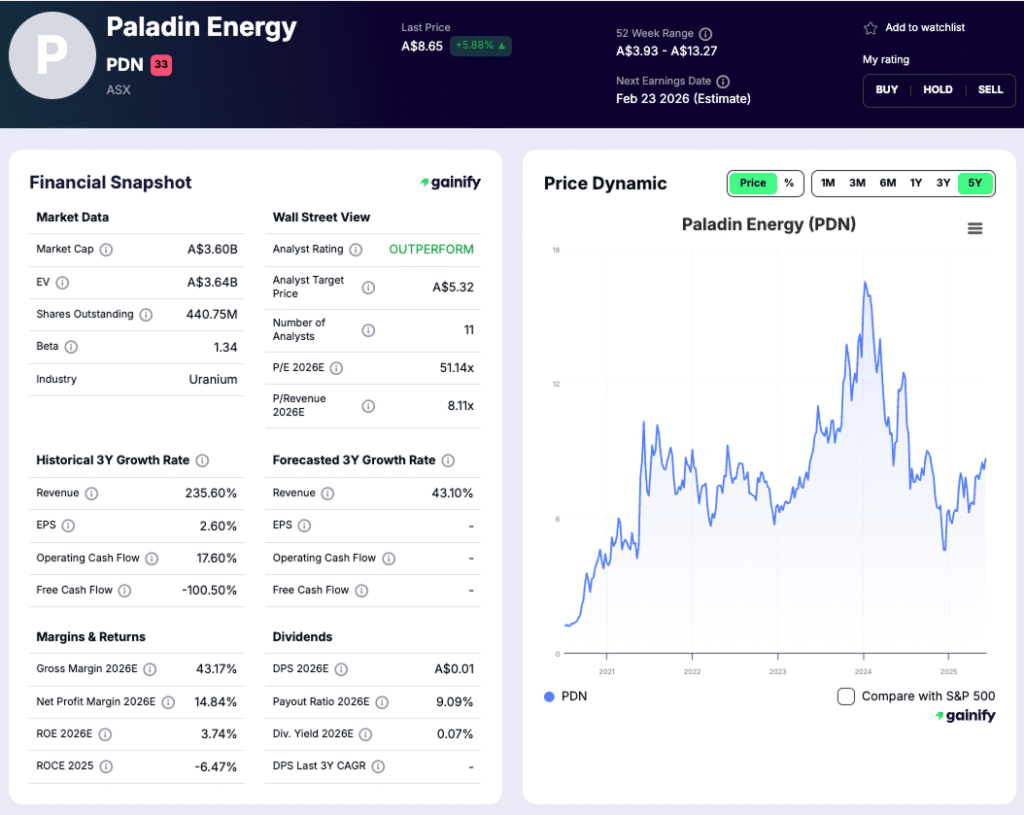
Energy Fuels (UUUU) – United States
- What It Does: Leading U.S. uranium producer; owns White Mesa Mill in Utah (the only conventional uranium mill operating in the U.S.); also expanding into rare earths.
- Catalysts: Positioned to benefit from U.S. government contracts for domestic supply; diversification into critical minerals.
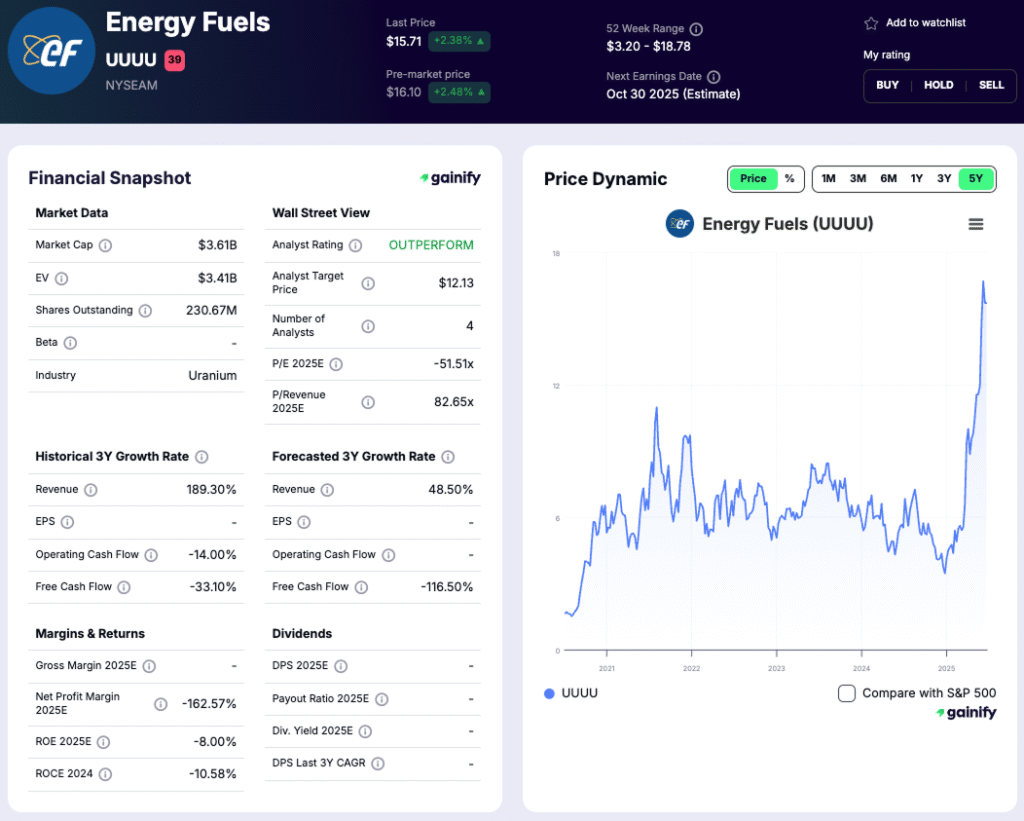
Uranium Energy Corp (UEC) – United States
- What It Does: U.S.-based producer focused on ISR projects in Texas and Wyoming, with additional assets in Canada’s Athabasca Basin.
- Catalysts: Low-cost ISR production; growth in U.S. as utilities seek non-Russian supply; exposure to long-term federal contracts.
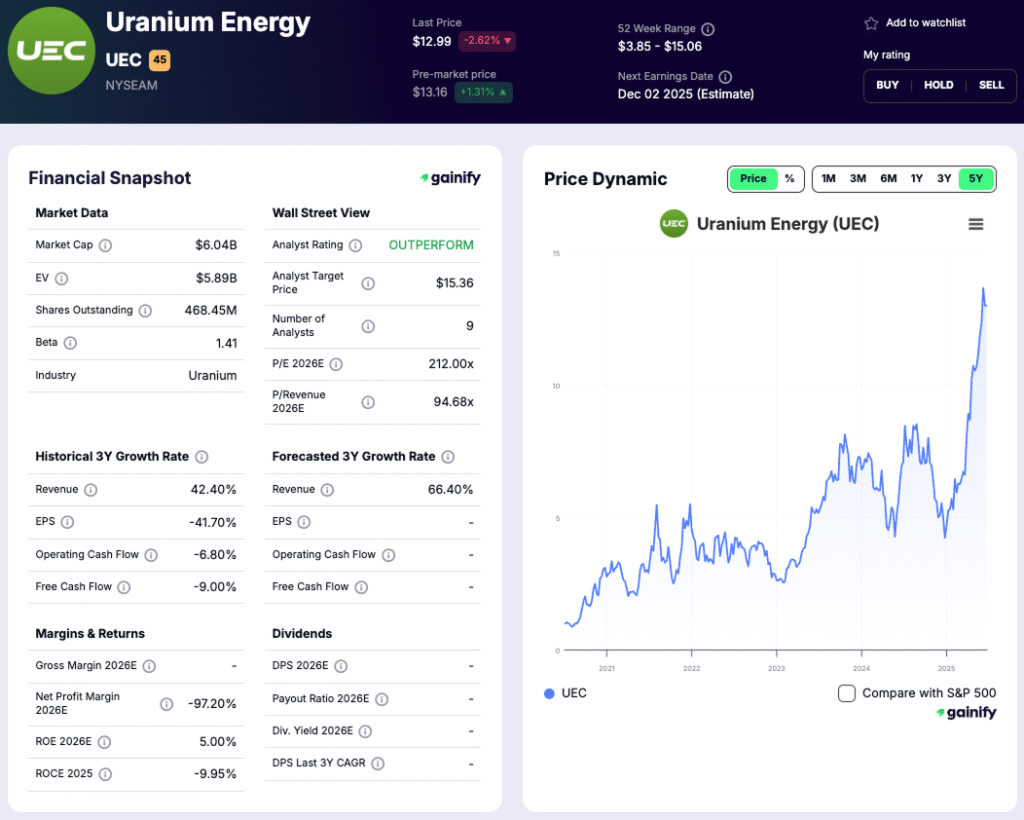
NexGen Energy (NXE, NXE.TO) – Canada
- What It Does: Developer of the Arrow project in Saskatchewan’s Athabasca Basin, one of the largest undeveloped uranium projects in the world.
- Catalysts: Exceptionally high-grade resource; potential to be a cornerstone supplier once operational.
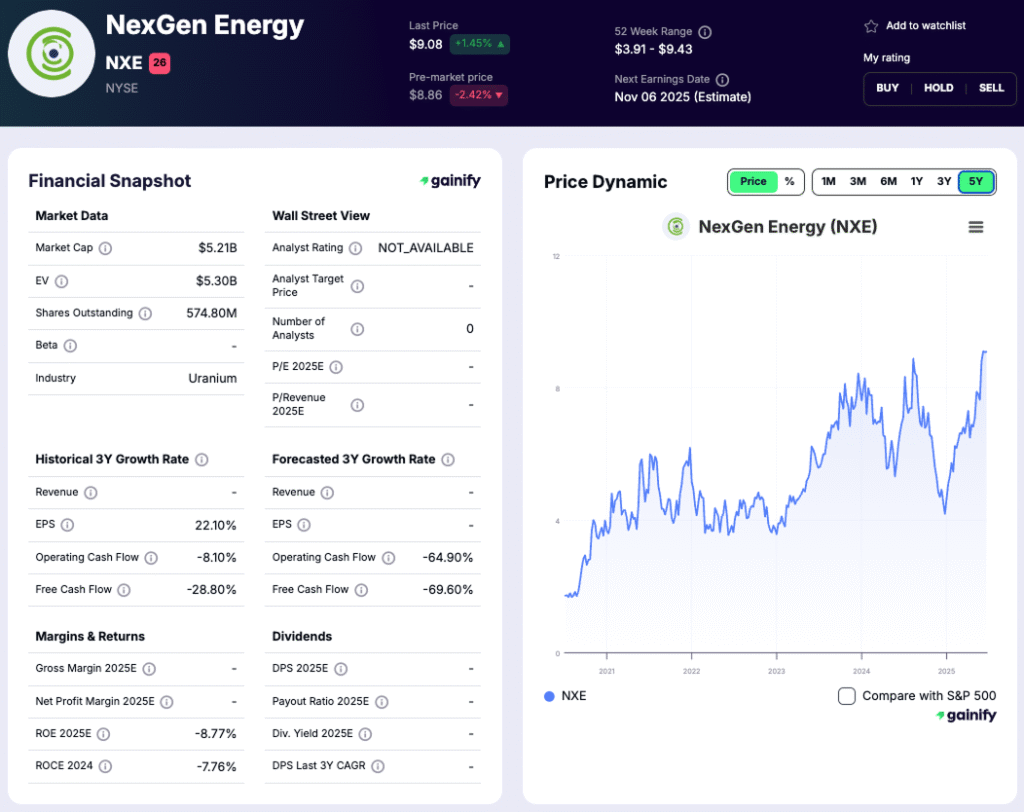
Denison Mines (DNN, DML.TO) – Canada
- What It Does: Exploration and development company with flagship Wheeler River project in the Athabasca Basin.
- Catalysts: First Canadian project designed for ISR mining; partnership potential with Cameco and Orano in the Basin.
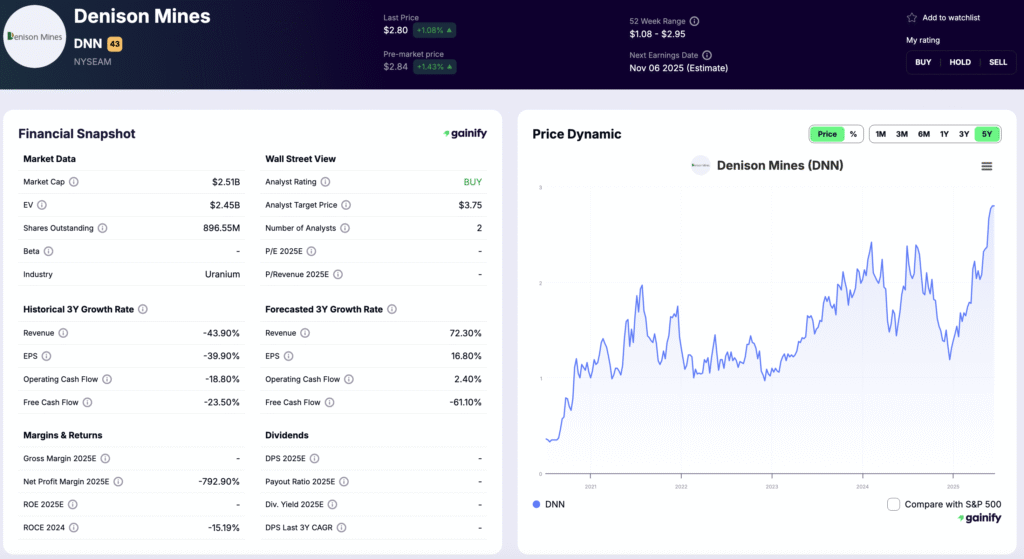
Global Atomic (GLO.TO) – Canada
- What It Does: Developing the Dasa project in Niger, one of Africa’s largest undeveloped uranium deposits.
- Catalysts: Transformative potential once in production; however, exposed to political instability and resource nationalism in Niger.
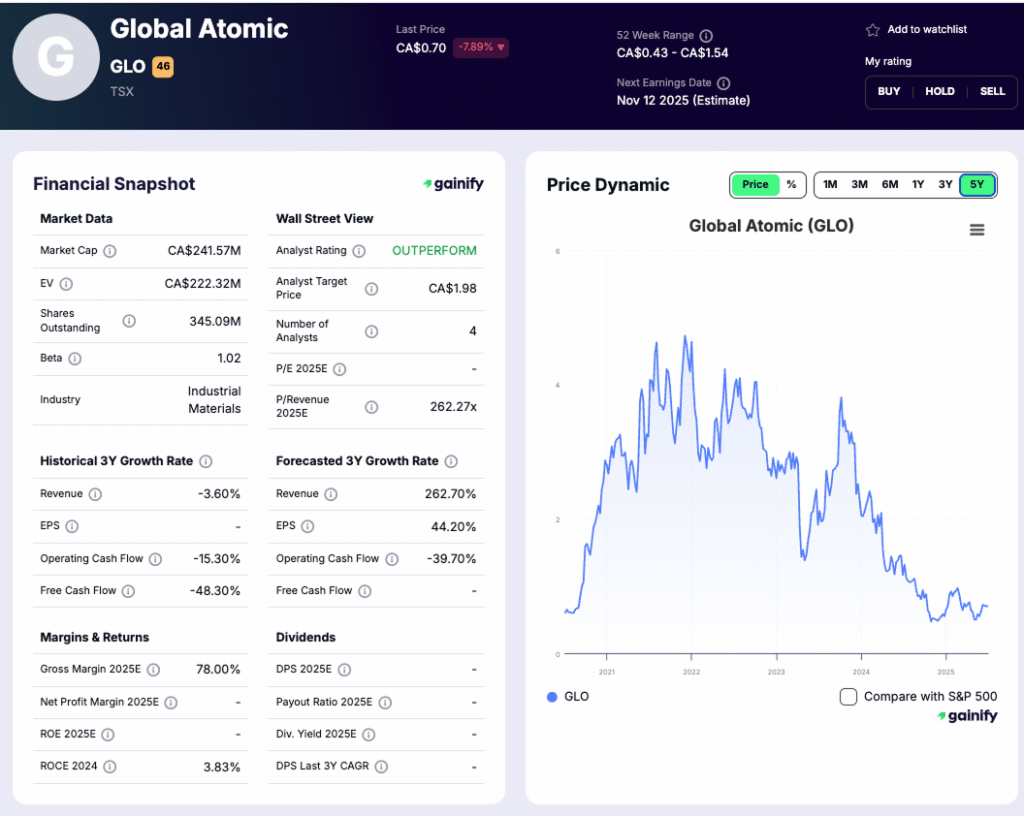
Ur-Energy (URG, URE.TO) – United States
- What It Does: Small-cap ISR producer with projects in Wyoming, including Lost Creek and Shirley Basin.
- Catalysts: Restart of Lost Creek; positioned to benefit from U.S. domestic uranium supply initiatives.
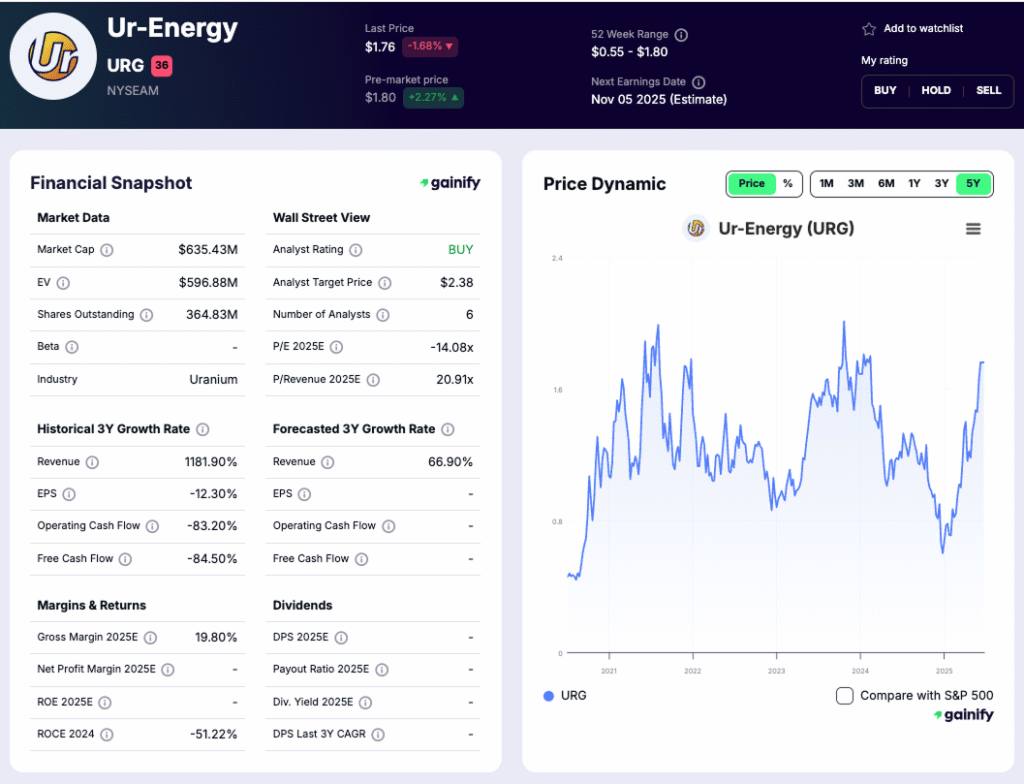
Navoi Mining & Metallurgy Combine (Private) – Uzbekistan
- What It Does: State-owned company and one of the world’s largest uranium producers. Operates several uranium mines across Uzbekistan, primarily using in-situ recovery (ISR) technology.
- Assets: Multiple ISR projects across the Kyzylkum Desert region; integrated uranium production facilities.
- Catalysts: Rising output as Uzbekistan increases its role in global uranium markets; government initiatives to attract foreign investment into mining; strategic partnerships with Russia and China.
Orano (Private, France – formerly Areva)
- What It Does: A major French state-owned nuclear fuel company with uranium mining operations in Niger, Kazakhstan, and Canada.
- Catalysts: Supplies European utilities; vertically integrated across the nuclear fuel cycle; political instability in Niger remains a risk.
Investment Risks
Investing in uranium miners requires tolerance for volatility and awareness of unique sector risks:
- Price Volatility: Uranium prices swing sharply, often disconnected from broader commodities.
- Regulatory Changes: Sudden policy shifts, such as nuclear phase-outs, can slash demand.
- Geopolitical Risk: Concentration of supply in Kazakhstan and Niger exposes the market to instability.
- ESG Concerns: Mining and nuclear waste raise environmental and political challenges.
- Capital Costs: New mines require billions upfront, with long payback horizons.
Conclusion
Uranium’s resurgence is one of the defining energy stories of the 2020s. Nuclear power is now firmly back on the policy agenda, with governments prioritising energy security and climate goals simultaneously.
The top uranium mining stocks from A to U: Cameco, Energy Fuels, Uranium Energy Corp, Kazatomprom, NexGen Energy, Denison Mines, Paladin Energy, Global Atomic, and Ur-Energy give investors a spectrum of opportunities, from established low-cost producers to high-growth developers.
For investors, uranium mining stocks offer powerful upside but demand careful risk management. Diversification across multiple companies and regions, combined with a long-term outlook, may be the best way to gain exposure to a commodity that is becoming indispensable for global energy security.




